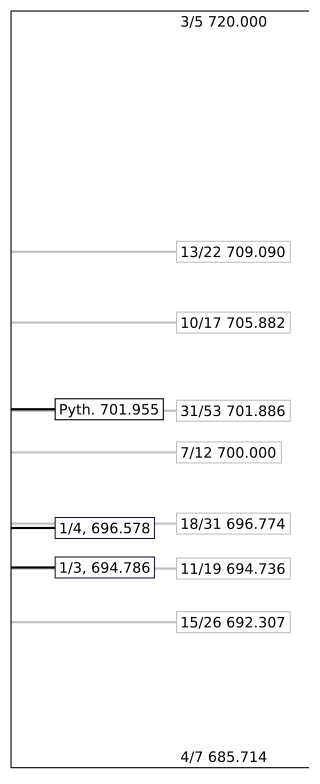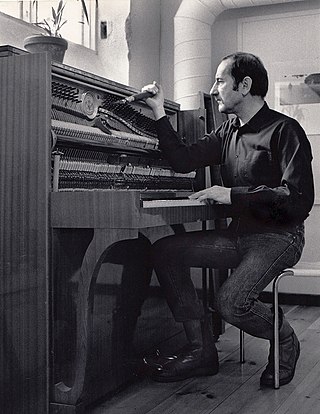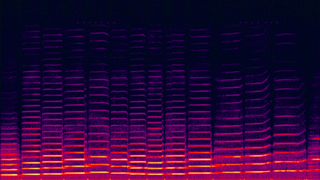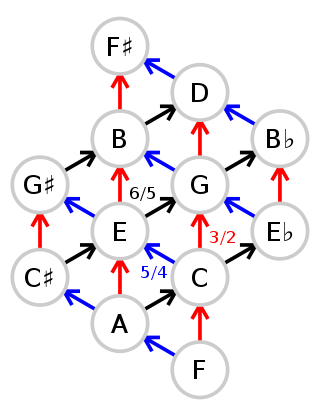
An equal temperament is a musical temperament or tuning system that approximates just intervals by dividing an octave into steps such that the ratio of the frequencies of any adjacent pair of notes is the same. This system yields pitch steps perceived as equal in size, due to the logarithmic changes in pitch frequency.

In music, just intonation or pure intonation is the tuning of musical intervals as whole number ratios of frequencies. An interval tuned in this way is said to be pure, and is called a just interval. Just intervals consist of tones from a single harmonic series of an implied fundamental. For example, in the diagram, if the notes G3 and C4 are tuned as members of the harmonic series of the lowest C, their frequencies will be 3 and 4 times the fundamental frequency. The interval ratio between C4 and G3 is therefore 4:3, a just fourth.
In music, notes are distinct and isolatable sounds that act as the most basic building blocks for nearly all of music. This discretization facilitates performance, comprehension, and analysis. Notes may be visually communicated by writing them in musical notation.

Pythagorean tuning is a system of musical tuning in which the frequency ratios of all intervals are determined by choosing a sequence of fifths which are "pure" or perfect, with ratio . This is chosen because it is the next harmonic of a vibrating string, after the octave, and hence is the next most consonant "pure" interval, and the easiest to tune by ear. As Novalis put it, "The musical proportions seem to me to be particularly correct natural proportions." Alternatively, it can be described as the tuning of the syntonic temperament in which the generator is the ratio 3:2, which is ≈ 702 cents wide.
In music theory, an interval is a difference in pitch between two sounds. An interval may be described as horizontal, linear, or melodic if it refers to successively sounding tones, such as two adjacent pitches in a melody, and vertical or harmonic if it pertains to simultaneously sounding tones, such as in a chord.

Pitch is a perceptual property that allows sounds to be ordered on a frequency-related scale, or more commonly, pitch is the quality that makes it possible to judge sounds as "higher" and "lower" in the sense associated with musical melodies. Pitch is a major auditory attribute of musical tones, along with duration, loudness, and timbre.
In music, two written notes have enharmonic equivalence if they produce the same pitch but are notated differently. Similarly, written intervals, chords, or key signatures are considered enharmonic if they represent identical pitches that are notated differently. The term derives from Latin enharmonicus, in turn from Late Latin enarmonius, from Ancient Greek ἐναρμόνιος, from ἐν ('in') and ἁρμονία ('harmony').

A fourth is a musical interval encompassing four staff positions in the music notation of Western culture, and a perfect fourth is the fourth spanning five semitones. For example, the ascending interval from C to the next F is a perfect fourth, because the note F is the fifth semitone above C, and there are four staff positions between C and F. Diminished and augmented fourths span the same number of staff positions, but consist of a different number of semitones.

In music theory, a perfect fifth is the musical interval corresponding to a pair of pitches with a frequency ratio of 3:2, or very nearly so.
The cent is a logarithmic unit of measure used for musical intervals. Twelve-tone equal temperament divides the octave into 12 semitones of 100 cents each. Typically, cents are used to express small intervals, to check intonation, or to compare the sizes of comparable intervals in different tuning systems. For humans, a single cent is too small to be perceived between successive notes.

A semitone, also called a minor second, half step, or a half tone, is the smallest musical interval commonly used in Western tonal music, and it is considered the most dissonant when sounded harmonically. It is defined as the interval between two adjacent notes in a 12-tone scale, visually seen on a keyboard as the distance between two keys that are adjacent to each other. For example, C is adjacent to C♯; the interval between them is a semitone.

Piano tuning is the process of adjusting the tension of the strings of an acoustic piano so that the musical intervals between strings are in tune. The meaning of the term 'in tune', in the context of piano tuning, is not simply a particular fixed set of pitches. Fine piano tuning requires an assessment of the vibration interaction among notes, which is different for every piano, thus in practice requiring slightly different pitches from any theoretical standard. Pianos are usually tuned to a modified version of the system called equal temperament.

Scientific pitch notation (SPN), also known as American standard pitch notation (ASPN) and international pitch notation (IPN), is a method of specifying musical pitch by combining a musical note name and a number identifying the pitch's octave.
The twelfth root of two or is an algebraic irrational number, approximately equal to 1.0594631. It is most important in Western music theory, where it represents the frequency ratio of a semitone in twelve-tone equal temperament. This number was proposed for the first time in relationship to musical tuning in the sixteenth and seventeenth centuries. It allows measurement and comparison of different intervals as consisting of different numbers of a single interval, the equal tempered semitone. A semitone itself is divided into 100 cents.

In music theory, a comma is a very small interval, the difference resulting from tuning one note two different ways. Traditionally, there are two most common comma; the syntonic comma, "the difference between a just major 3rd and four just perfect 5ths less two octaves", and the Pythagorean comma, "the difference between twelve 5ths and seven octaves". The word comma used without qualification refers to the syntonic comma, which can be defined, for instance, as the difference between an F♯ tuned using the D-based Pythagorean tuning system, and another F♯ tuned using the D-based quarter-comma meantone tuning system. Intervals separated by the ratio 81:80 are considered the same note because the 12-note Western chromatic scale does not distinguish Pythagorean intervals from 5-limit intervals in its notation. Other intervals are considered commas because of the enharmonic equivalences of a tuning system. For example, in 53TET, B♭ and A♯ are both approximated by the same interval although they are a septimal kleisma apart.

In music, a fifteenth or double octave, abbreviated 15ma, is the interval between one musical note and another with one-quarter the wavelength or quadruple the frequency. It has also been referred to as the bisdiapason. The fourth harmonic, it is two octaves. It is referred to as a fifteenth because, in the diatonic scale, there are 15 notes between them if one counts both ends. Two octaves do not make a sixteenth, but a fifteenth. In other contexts, the term two octaves is likely to be used.

Music theory analyzes the pitch, timing, and structure of music. It uses mathematics to study elements of music such as tempo, chord progression, form, and meter. The attempt to structure and communicate new ways of composing and hearing music has led to musical applications of set theory, abstract algebra and number theory.
In music theory, an inversion is a rearrangement of the top-to-bottom elements in an interval, a chord, a melody, or a group of contrapuntal lines of music. In each of these cases, "inversion" has a distinct but related meaning. The concept of inversion also plays an important role in musical set theory.

Five-limit tuning, 5-limit tuning, or 5-prime-limit tuning (not to be confused with 5-odd-limit tuning), is any system for tuning a musical instrument that obtains the frequency of each note by multiplying the frequency of a given reference note (the base note) by products of integer powers of 2, 3, or 5 (prime numbers limited to 5 or lower), such as 2−3·31·51 = 15/8.

The 833 cents scale is a musical tuning and scale proposed by Heinz Bohlen based on combination tones, an interval of 833.09 cents, and, coincidentally, the Fibonacci sequence. The golden ratio is , which as a musical interval is 833.09 cents. In the 833 cents scale this interval is taken as an alternative to the octave as the interval of repetition, however the golden ratio is not regarded as an equivalent interval. Other music theorists such as Walter O'Connell, in his 1993 "The Tonality of the Golden Section", and Lorne Temes in 1970, appear to have also created this scale prior to Bohlen's discovery of it.





























